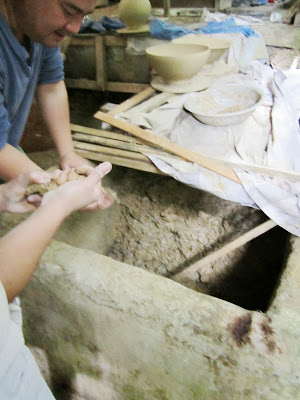We had some remaining Complimentary Room Nights or CRNs at the Baguio Country Club to consume before the end of September. We decided to insert a couple of unpredictable days in Sagada between our predictable days in Baguio. As luck would have it, while having a leisurely breakfast on the morning of our departure to Sagada, we bumped into our old family friend, Anton Carag, eco-tour expert and river master, who basically laid-out our itinerary and referred us to his trusted Sagada tour guide of over a decade, Fabian, FBI (i.e., Full Blooded Igorot and proud of his heritage). Many thanks Anton! Our trip would not have been as meaningful without your intervention.
 |
| Our route from Baguio to Sagada |
For starters, Super Typhoon USAGI (locally known as ODETTE) was right above Batanes on the Saturday morning that we were departing from Baguio to Sagada. It was raining in Baguio but the weather was not severe. We were also assured that the road to Sagada had long been concreted, except for some of the usual patches of landslides and ongoing repairs. So, off we went via La Trinidad (the Strawberry Capital of the Philippines) and the Baguio-Bontoc Road (a great value toll-fee of P15 one-way for the 4x4 KIA doublecab pick-up I borrowed from Dad), also known as the Halsema Highway.
 |
| I just googled this picture of the toll gate. |
In light of the weather, we were resigned to miss-out on the awesome mountain views along the way (which we saw on our return trip) but we did not expect to encounter near zero visibility beyond the car in front of ours during half of our road trip. Between the rainfall, fog and mist, it was as if we were driving through the densest clouds. Anton rightfully estimated our road trip to last approximately 7 hours; we made it in 4.5 hours. Departed Baguio Country Club at 11:30 am and arrived in Sagada at 4 pm--a tiring but adventurous drive. We had to make a couple of stops along the way to take a leak and I noticed, upon exiting the vehicle, the smell of pine--kinda like the smell of Baguio when I was a kid 35 years ago.
 |
| George's Guest House, our home in Sagada |
On Sunday morning, Fabian brought us to the northern part of Sagada, where we picked-up another local guide, Norma, who led our trek to Bomod-Ok Falls or the Big Falls. It was an hour and half each way but the return trip (which was mostly going up) was particularly brutal. It was worth every step and I do recommend that it be taken slowly and deliberately, as there are many opportunities to slip, fall, injure yourself or worse. Crossing the river at one point (going to the falls and back) was particularly nerve wracking, as the strong current could have easily made us slip and fall into the water.
 |
| With Norma and Fabian before our trek to Bomod-Ok Falls |
After lunch, we were off to Narda's Peak for a comprehensive view of Sagada's rice terraces, which would probably be a great launching site for paragliding and hang gliding--provided there was a designated landing site and "recovery cable system" to return gliders and equipment back to the Peak, much like the existing cable systems used by the local miners in Sagada.
 |
| Narda's Peak . . . paragliding anyone? |
We visited Sagada Weaving. It was Sunday, so no one was at work. "No Picture Taking" said the signs around the shop. Fabian explained that most of the weavers were elderly Igorot women who believed that those taking their pictures were stealing their souls.
Thereafter, Sagada Pottery, where beautiful stoneware pottery is locally crafted. We met a local craftswoman, Siegfried, diligently tending the kiln, while patiently articulating the laborious process of refining the local clay before it is made into any object. I felt sorry that I could only afford to purchase a small pipe.
Finally, a visit to a nearby lake (large pond) where the locals like to picnic. A brief stroll from the lake to an elevated point gave us a glimpse of Tirad Pass, as far away to the west as Ilocos Sur. The Battle of Tirad Pass was a battle in the Philippine-American War in 1899 where General Gregorio del Pilar and most of his men, severely outnumbered by the American regiment, lost their lives to enable Emilio Aguinaldo to escape to Palanan, Isabela via . . . Sagada, of course!
 |
| Tirad Pass, Ilocos Sur in the extreme background |
Monday morning and our first stop was a peculiar limestone formation with . . . hanging coffins, which Sagada is famous for. According to Fabian, the dead in Sagada wanted to be in the light or wanted to have a full view of the mountains they loved. Hence, their coffins were place at the entrance of caves or hung high on the side of mountains. Our second stop was Lumiang Cave, which may be the oldest burial cave in Sagada. Then, we were off to Eco-Valley, which had more hanging coffins.
 |
| Hanging coffins from afar |
 |
| A bit closer. Yes, it's skull and bones. Fabian himself arranged it. |
 |
| Grand opening of the Lumiang Cave |
 |
| No spelunking on this trip. |
 |
| Selina, who took all the pictures, hiked with me every step of the way! |
At the end of the day, all roads in Sagada lead to the Yogurt House, which serves the best food in town.
 |
| Best food in town |































No comments:
Post a Comment